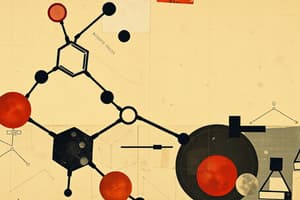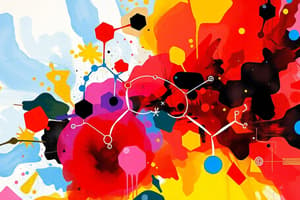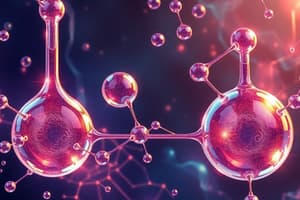Podcast
Questions and Answers
What type of derivative is produced when alkenes react with halogens?
What type of derivative is produced when alkenes react with halogens?
- 1,2-dihalogen derivatives (correct)
- Alkyl halides
- Trihalogen derivatives
- Monohalogen derivatives
What occurs first in the mechanism of halogenation of alkenes?
What occurs first in the mechanism of halogenation of alkenes?
- Departure of the further halogen as a halide
- Flow of electrons from the π bond to the nearer halogen (correct)
- Formation of ring intermediates
- Formation of alkenyl halides
Which of the following halogens readily reacts with alkenes?
Which of the following halogens readily reacts with alkenes?
- Chlorine (Cl2) (correct)
- Argon (Ar)
- Fluorine (F2)
- Iodine (I2)
What role does the farther halogen play during the reaction mechanism?
What role does the farther halogen play during the reaction mechanism?
Which step correctly follows after the reactants get closer in the halogenation mechanism?
Which step correctly follows after the reactants get closer in the halogenation mechanism?
What defines an addition reaction?
What defines an addition reaction?
Which type of addition reaction involves electron pair donation for bond formation?
Which type of addition reaction involves electron pair donation for bond formation?
Which of the following compounds is most likely to undergo addition reactions?
Which of the following compounds is most likely to undergo addition reactions?
What type of addition reaction occurs at a conjugated system?
What type of addition reaction occurs at a conjugated system?
What is a unique characteristic of rearrangement reactions?
What is a unique characteristic of rearrangement reactions?
Flashcards
Addition Reaction
Addition Reaction
A chemical reaction where all atoms of the reagent are added directly to the reactant, forming a new molecule that contains all atoms from both the reactant and reagent.
Addition Reaction: Unsaturated Compounds
Addition Reaction: Unsaturated Compounds
Reactions where the reagent adds to a carbon-carbon double or triple bond in an unsaturated molecule.
Electrophilic Addition
Electrophilic Addition
A type of addition reaction where an electron-seeking species (electrophile) attacks a site of high electron density, often a double or triple bond.
Nucleophilic Addition
Nucleophilic Addition
Signup and view all the flashcards
Nucleophilic Addition at Conjugated System
Nucleophilic Addition at Conjugated System
Signup and view all the flashcards
Halogenation of Alkenes
Halogenation of Alkenes
Signup and view all the flashcards
Rate Law for Halogenation
Rate Law for Halogenation
Signup and view all the flashcards
Halogenation Mechanism
Halogenation Mechanism
Signup and view all the flashcards
Halonium Ion
Halonium Ion
Signup and view all the flashcards
Electrophile
Electrophile
Signup and view all the flashcards
Study Notes
Lecture 5: Addition Reactions and Their Mechanisms
- Addition reactions involve adding all reagent atoms to the reactant, resulting in a product containing all original and added atoms.
- Unsaturated compounds (alkenes and alkynes) feature double or triple bonds, which act as electron-pair donors for bond formation in these reactions.
- Different types of addition reactions exist: electrophilic addition, nucleophilic addition, nucleophilic addition to conjugated systems, and free radical addition.
Types of Addition Reactions
-
Electrophilic Addition: A characteristic reaction of alkenes where pi electrons react with electrophiles.
- Electrophiles include proton donors (Brønsted-Lowry acids), neutral reagents (like bromine), and Lewis acids (like BH3, BF3, AlCl3).
- Carbocation formation is the rate-determining step.
- Rate = k[alkene][ENu]
- Halogen addition (halogenation) is a type of electrophilic addition involving halogens like chlorine (Cl2) and bromine (Br2). This leads to 1,2-dihalogen derivatives. The mechanism involves π-electron polarization of the halogen, electrophilic addition, and bromide attack on the carbocation.
- Addition of bromine to an alkene results in a racemic mixture (R,R and S,S isomers) in the addition to cis-alkene, while it forms a meso isomer (R,S isomer) in the addition to trans-alkene. The addition is anti-addition, which places the halogen atoms on opposite faces of the double bond.
- Electrophilic addition of hydrogen halides (HX) to alkenes (hydrohalogenation) follows Markovnikov's rule. The hydrogen atom adds to the carbon atom with the most hydrogen atoms. The result is a pair of enantiomers, while the resulting addition to symmetric alkenes forms a single product.
-
Nucleophilic Addition:
- The nucleophile attacks a carbon atom, forming a carbanion intermediate.
-
Nucleophilic Addition to Conjugated Systems: Conjugate addition (or 1,4-addition) occurs when a nucleophile adds to a conjugated system (e.g., a conjugated diene).
-
Free Radical Addition: Free radical addition occurs when peroxides are present, producing an anti-Markovnikov product; with this process, the hydrogen attaches to the carbon atom with fewer hydrogen atoms. The addition of HBr to a conjugated diene proceeds with 1,2-addition and 1,4-addition.
Rearrangement Reactions
- Rearrangement reactions involve a change in the carbon skeleton of a molecule forming a structural isomer of the original molecule. A substituent in the molecule moves from one atom to another atom. Migrating groups don't leave the molecule.
- Classification includes those to electron-deficient carbon (Wagner-Meerwein, Pinacol, Benzilic Acid, Arndt-Eistert) and those to electron-deficient nitrogen (Hofmann, Curtius, Schmidt, Lossen, Beckmann).
Studying That Suits You
Use AI to generate personalized quizzes and flashcards to suit your learning preferences.




